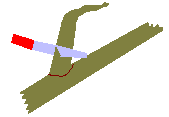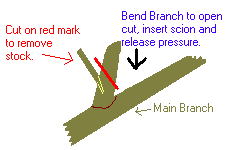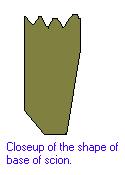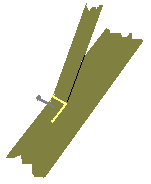Frameworking
Frameworking is the name given to the technique of converting old fruit trees to different varieties. This is sometimes necessary if the existing variety is of inferior quality or a poor cropper.
Frameworking is probably a slightly better method than Topworking as the tree will fruit quicker on the new grafts. The main branch system is left intact and the grafts are done on the smaller secondary branches. You will need a considerable number of scions to convert the whole tree.
Stub Graft
Method -
Prepare the tree by cutting away the branches to only the main framework of branches but leave a number of secondary branches on. These should be from ¼ - 1 inch (6 - 25mm) in diameter.
 The scion should be prepared from well-ripend shoots of the previous years growth. They should have about 8 buds along their length. Make a short slanted cut across the base the make a wedge shape.
The scion should be prepared from well-ripend shoots of the previous years growth. They should have about 8 buds along their length. Make a short slanted cut across the base the make a wedge shape.

The stock is then prepared by making a ½ inch (12mm) long cut into a lateral secondary branch, at a 45 degree angle.
 Carefully pull the branch to open the cut and slide the scion into the prepared slit in the stock so that the cut face of the scion is in contact with the wood of the stock. Release the pressure on the branch so that it grips the scion.
Carefully pull the branch to open the cut and slide the scion into the prepared slit in the stock so that the cut face of the scion is in contact with the wood of the stock. Release the pressure on the branch so that it grips the scion.
Cut the branch off neatly, just above the graft and paint the area with wound paint.
Inverted-L Graft
This graft can be used in place of the previous Stub graft. They are done from March to May.
Method -
 Cut the scions to a wedge shape with one side longer than the other.
Cut the scions to a wedge shape with one side longer than the other.
 Prepare the branches to receive the scions by making an incision in the shape of an inverted 'L'
Prepare the branches to receive the scions by making an incision in the shape of an inverted 'L'
 Lift the flap of bark and insert the scion. Close the flap of bark and pin in place with a panel pin through the bark and scion and into the wood.
Lift the flap of bark and insert the scion. Close the flap of bark and pin in place with a panel pin through the bark and scion and into the wood.
Paint the graft with wound paint.
© copyright 1999, P. A. Owen

